The Complete Guide to Nonstick Cookware, Including How to Properly Care for It
Dotdash Meredith and Yahoo Inc. may earn commission or revenue on some items through the links below.
Once you own nonstick cookware, here’s how to make it last.
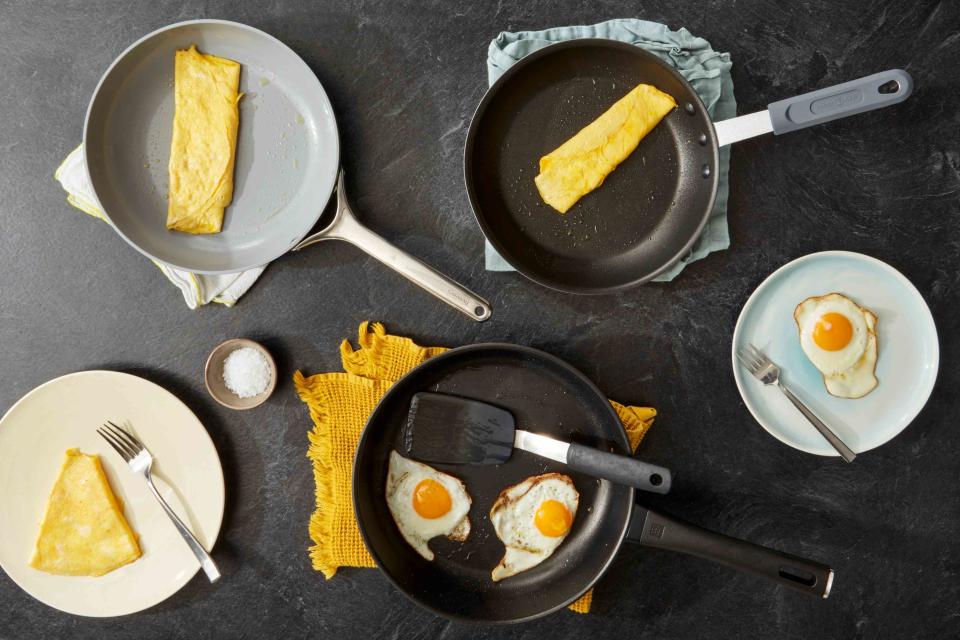
Food & Wine/Joy Kim
For some, cooking is an enjoyable task. For others, it’s a mundane means to an end. But for both groups, cleaning up is a chore and a bore. Enter nonstick cookware. It keeps stick-prone foods (think delicate fish filets, eggs, and rice) dancing in the pan, resulting in better-finished dishes and reducing the time and energy required to tidy up post-meal. Learn why and how to use it, why chefs love it, and how to care for it.
What is nonstick cookware — and why use it?
Thanks to a coating applied to its base material (usually aluminum or stainless steel) or a layer of baked-on oil achieved through seasoning (as in the case of cast iron), nonstick pots and pans don’t allow foods to stick to their surfaces during cooking. This means less fuss and frustration when cooking, plus easier dish-washing duty later.
“Nonstick is great for tasks that involve quick cooking techniques and is very easy to clean afterward,” says chef Donald Young of Chicago’s Duck Sel. Another plus: You can use less butter or oil in dishes since nonstick cookware reduces the reliance on fat to keep foods freely moving. And options abound; we tested 20 to find our favorite nonstick cookware sets.
Types of nonstick cookware
When most people think of nonstick cookware, they’re picturing a skillet that’s been coated with polytetrafluoroethylene (PTFE). One of the best-known PTFE brand names is Teflon, though the use of this material is less and less common, and instead, brands have been using alternative nonstick coatings.
It’s a bit less friction-free than PTFE pans, but ceramic cookware is also nonstick, although not truly ceramic. It’s metal covered with a layer of silicone oil to create a nonstick interior that also boasts a glossy shine. There are claims that this nonstick surface is safer than PTFE nonstick, and it often comes in designer colors, leading to a recent rise in popularity.
Once seasoned, cast iron cookware is nonstick, too. And we’re not talking about adding salt or spices but a process called polymerization in which heat transforms oil used in cooking into a hard, slick, naturally nonstick layer. Cast iron pans must be periodically re-seasoned to hold onto their food-releasing features, but the cookware’s excellent heat conduction, as well as its almost-indestructible nature, are worth a little extra effort. We love these versatile cast iron skillets.
Stainless steel is not nonstick (we still love it and ranked the best bets for stainless steel cookware sets), but seasoned carbon steel is. Thanks to its marriage of coated nonstick’s perks, light and easy to handle, with those of cast iron, even heating and long-lasting, this material is having a moment with chefs and home cooks.
Nonstick cookware we love
Made In The Non Stick 7-Piece Set
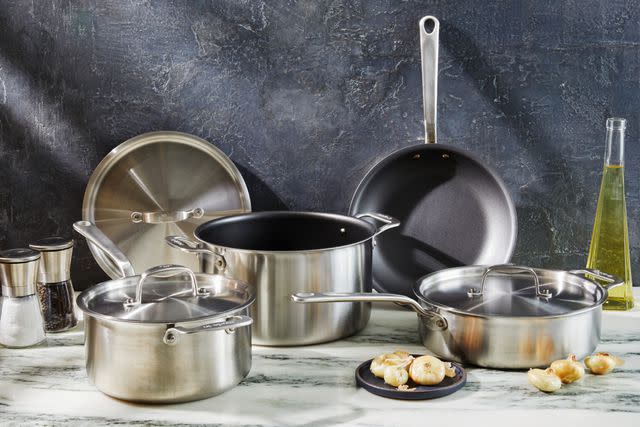
Food & Wine / Will Dickey
There’s a lot of nonstick cookware to choose from, but Made In’s nonstick set tops our list thanks to its 5-ply stainless steel construction with two layers of professional-grade nonstick coating, induction compatibility, and stylish good looks.
Price at time of publish: $599
T-fal Ultimate Hard Anodized Nonstick 12-Piece Cookware Set
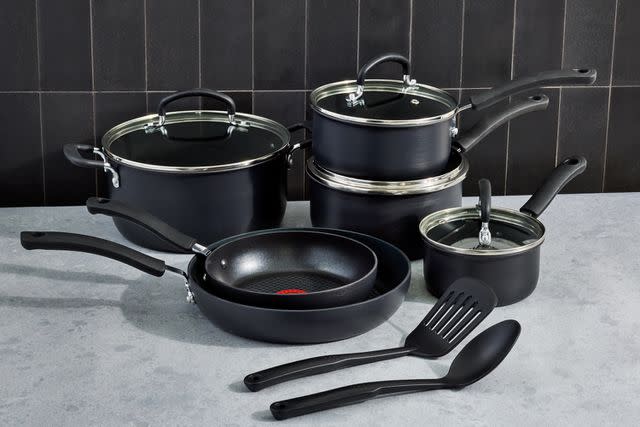
Food & Wine / Jennifer Causey
T-fal’s 12-piece nonstick set also performed well in our tests, with exceptional nonstick qualities, a nice range of pot and pan sizes, and an affordable price point. We particularly liked its nonstick-coated rivets that prevent food from sticking and the transparent lids for easy stovetop monitoring. We also found this set very easy to clean, and the deep pans are perfect for cooking large batches for a family or crowd.
Price at time of publish: $93
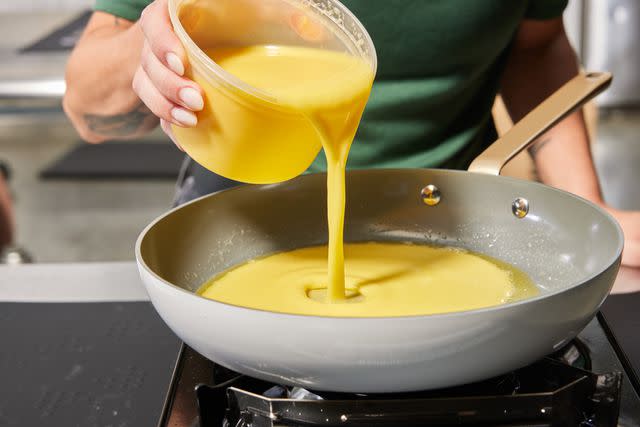
Food & Wine / Will Dickey
What to cook in nonstick cookware
Since foods come out of nonstick cookware so easily, using them for items that often get glued to the pan is a no-brainer. Coated nonstick really shines when used with eggs. “I love cooking omelets and over-easy eggs in nonstick,” says Young. “It is rather soothing to see that nonstick coating work right away, and the eggs just slide around and the ease you have flipping them.” Chef Junior Borges of Meridian in Dallas shares another favorite nonstick use. “I love to use it for savory pancakes at the restaurant,” he says.
Young prefers cast iron for other proteins. “I feel much safer searing meats and fish in a cast iron since it is just an oil coating, and you can’t do any high heat cooking in these pans [coated nonstick] because it will burn the coating away faster,” he says. Borges again agreed with Young. “One con of nonstick [that’s not carbon steel or cast iron] is that you can't use it at a super high heat.”
How to care for nonstick cookware
For PTFE nonstick pieces, avoid using metal cooking utensils, which can scratch the coating and shorten its lifespan. Ceramic’s coating is more durable, but it’s still smart to be careful with metal utensils.
There are other nonstick coating no-nos, too.
Don’t preheat the pan empty; while you’ll need minimal amounts, always put oil or butter in before turning on your burner.
Don’t use it on high heat; it will break down the nonstick surface.
Don’t stack nonstick cookware when storing. The metal bottom of the nesting pan can cause the same problem metal utensils can: scratches in the coating that lead to its failure.
Don’t use cooking spray. It leaves a hard-to-remove sticky film that builds into a barrier between your food and the surface, robbing it of its nonstick properties.
Don’t rinse a hot nonstick pan with cold water. The quick temperature change could cause warping.
Don’t just slide it in the oven. Many nonstick pieces can’t handle the heat. Check the manufacturer’s instructions to see if your pan is oven-safe, and if so, to what temperature.
When it comes to cleaning, PTFE pieces are not dishwasher-safe, and while some ceramic brands technically are, handwashing with a soft-bristled brush is recommended to keep the coating stronger for longer.
Cast iron and carbon steel are oven-safe to any temperature (and can handle metal utensils), but must be continually re-seasoned. While neither should ever see the inside of a dishwasher, cleaning is usually a cinch, according to Borges. “I found the best way is just rinse it and wipe it out if you have cooked something light,” he says.
If a few stuck-on food bits require a nudge (a sign it’s time to re-season), use a brush or make a paste with Kosher salt and give it a rub. Rust is cast iron’s No. 1 enemy, so don’t submerge it in water, and be sure to dry it completely before putting it away. Also, wipe a little oil onto its surface with a soft cloth after each use to stretch the time between seasoning sessions.
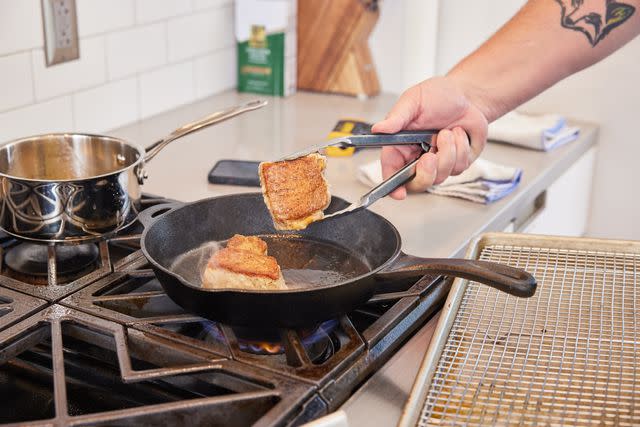
Food and Wine / Russell Kilgore
How — and why — to season nonstick cookware
Both cast iron and carbon steel pans need to be seasoned and periodically re-seasoned to remain nonstick. Most cast iron pans come pre-seasoned, but over time, you’ll need to re-season them. Most carbon steel pans come unseasoned, so you’ll need to do this before the first use. The process for both is similar.
Start by placing a foil-lined baking sheet on the bottom rack of your oven and preheat it. Crank it up to 450 to 500 degrees Fahrenheit for cast iron and set it at 400 to 475 for carbon steel. While the oven temperature rises, give your pan a thorough cleaning. For carbon steel, wash it well; many brands are covered in a protective coating at the factory to keep the bare metal free of rust, and it must be removed.
Next, brush or wipe a thin layer of neutral, high-smoke-point oil (like vegetable or canola) over the entire cooking surface and the pan’s exterior.
Place the oiled pan upside down in the oven on the center rack, positioned above the foil-lined baking sheet (to catch any drips), and leave it to “cook” for an hour. Let it cool in the turned-off oven, and once you remove the pan, if there is any excess oil, wipe it off.
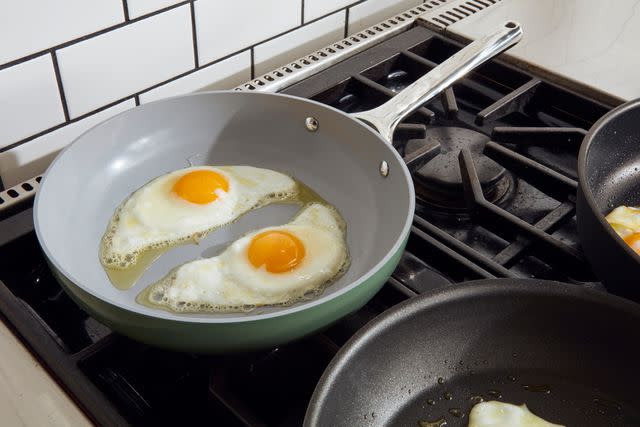
Food & Wine/Joy Kim
When to replace your nonstick cookware
With proper care and continual re-seasoning, both cast iron and carbon steel cookware can last generations. But the coatings on other kinds of nonstick wear off over time (and the coating on ceramic cookware tends to wear off faster), so they won’t be heirlooms. Most experts recommend replacing nonstick cookware every five years, but how long it actually lasts depends on its construction. The more coating layers it has, the longer it will hold up to repeated uses and washings. One caveat: If you have nonstick cookware made prior to 2015, you may want to rid of it now. It may have PFOA in its coating, a chemical no longer used due to possible health hazards.
The biggest clue it’s time to toss a nonstick pot or pan is when bits of its finish begin chipping off. You don’t want pieces of your pan in your dinner. And, with the coating comprised, food will start sticking. Once it is failing to do its namesake job, give it the boot and get some new.
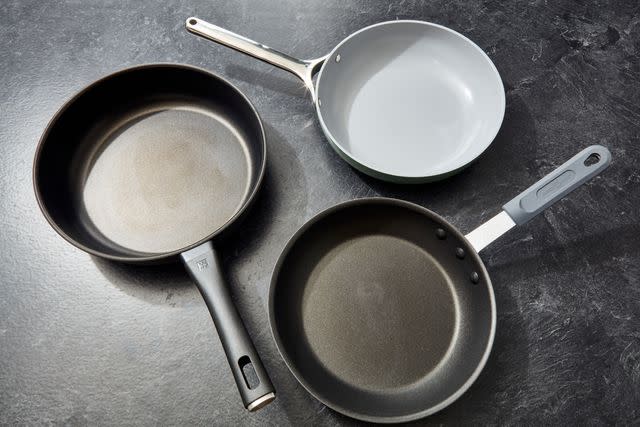
Food & Wine / Joy Kim
What to look for in a quality nonstick pan
No nonstick should require much effort to clean, but keep in mind that any non-coated rivets can be sticky spots. Construction is key, too: The more layers of coating a piece has, the longer it will easily release your dish. Other favorable factors include a comfy handle and the ability to distribute heat evenly. Some features will be specific to your needs. If you’ll be finishing a lot of your dishes in the oven, opt for an oven-safe pan and pay attention to its maximum heat tolerance. Also, consider how much food you’ll cook in it to determine the right size.
More nonstick cookware we love
Caraway Ceramic 12-Piece Cookware Set
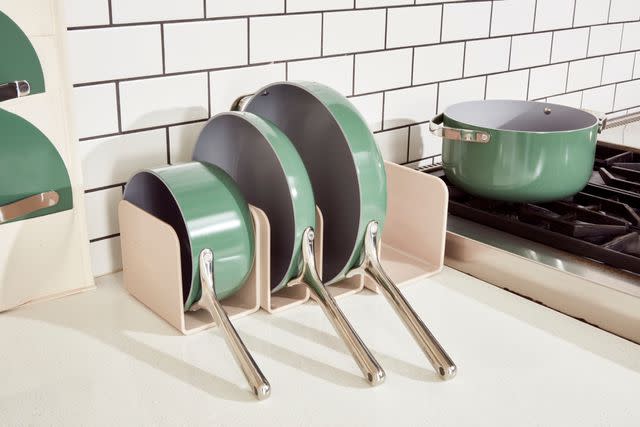
Food & Wine / Joy Kim
For a ceramic pick, we like Caraway. The brand uses a nonstick ceramic with an aluminum core, which provides a robust, heat-tolerant, slippery coating. It always aces our egg tests, and apart from its near-perfect nonstick surface, pieces offer a modern flair that looks good in almost any kitchen.
Price at time of publish: $356
Our Place Always Pan 2.0
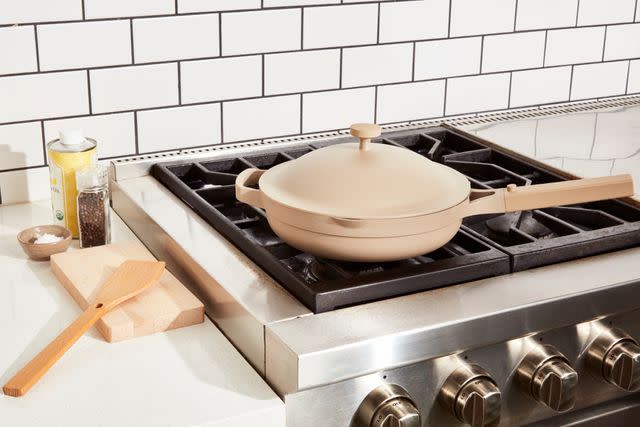
Food & Wine / Joy Kim
If you don't want to commit to a full set, we recommend Our Place's Always Pan 2.0. The multi-purpose pan features a smooth nonstick surface, and even better: It also comes with a steamer basket, a colander, and a beechwood spatula that cleverly nests into the handle. Whether you're low on space or simply wish to dip your toes into the world of nonstick, this all-in-one pan is a great option.
Price at time of publish: $150
Our Expertise
Jennifer Kornegay is a freelance food writer who has written for Garden & Gun, Condé Nast Traveler, The Local Palate, Southern Living, thekitchn.com, and more. To write this guide, she used her expertise and consulted a chef.
For more Food & Wine news, make sure to sign up for our newsletter!
Read the original article on Food & Wine.

